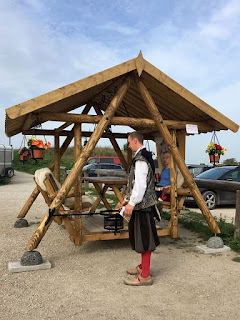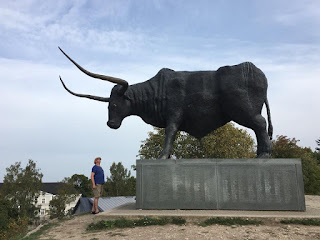We said our goodbyes to Luke & Jordi from Juke Media and headed east. It was getting near teatime so we parked up in the middle of Rakvere, right next to the fitness centre/skate park. We had a walk around the town and found a place to eat. It was still lovely and warm so chose a café with a table outside overlooking the square.
One thing I’ve noticed in all the towns we’ve visited in Estonia is that they have some great art work and places for people to meet and hang out. I love their laid back vibe. It’s probably due to only 1.3 million people living in a country a fifth of the size of Britain, there’s plenty of room for everyone.Next morning we were out and about exploring. I’d like to say at the crack of dawn but we can never getting going much before 10:30, unless we make a huge effort lol. We walked up the strangest set of steps to the castle on the hill.
There was a bit of a market going on and someone was selling the coolest looking swingy seat we’ve ever seen.
nstead of paying to enter the castle we decided to walk round the outside. We saw the biggest bull perched on the hillside. It turned out to be another monument to Estonians killed in the war.
The town is well worth a wander round with a mix of state of the art buildings, traditional wooden painted houses and everything in between.
We left Rakvere and headed for Narva.
Narva is an Estonian town, right on the Russian border.
When we read the following from Lonely Planet, we had to see it for ourselves ...
“Estonia’s easternmost city is separated from Ivangorod in Russia by the Narva River and is almost entirely populated by Russians. It’s quite literally a border town: the bridge at the end of the main street is the country’s principal link with Russia and no-man’s-land protrudes right up to the edge of the town square. Aside from its magnificent castle and baroque Old Town Hall, most of Narva’s outstanding architecture was destroyed in WWII. The reconstructed city has a melancholy, downtrodden air; the prosperity evident in other parts of the country is visibly lacking. Yet Estonia’s third-largest city is an intriguing place for a (brief) visit – you’ll find no other place in Estonia quite like it.”
That sums it up perfectly. People were fishing on both sides of the river yet I doubt their paths would ever cross? We could see them and they could see us but without a tonne of red tape you couldn’t walk or drive a few more hundred metres east.
It was strange to see Russia from where we were standing knowing we wouldn’t go any further. I’ve been and honestly, I’ve no desire to go back. We found Narva intriguing, it isn’t pretty but it’s well worth going.
Heading south again around lake Peipsus we followed google maps to Tartu. We stopped for the night at Pusi Kula as there was a campsite there and we needed water.
Turtu is the second largest city in Estonia after Tallinn. It’s a university town and a great place to spend the day. We had a lovely walk round using the self guided walking tour from the tourist information office. It’s really pretty with lots of designer shops and stunning architecture. We ate lunch out again which didn’t break the bank.
The legend describing the division of the town between the two states says that in old Livonia, Valga developed as a single town. When the republics of Estonia and Latvia were formed, it was impossible to decide which country the town should become part of. The border issue was resolved in 1920 by the English colonel Tallents. It was decided to divide the town in half, one side for Estonians and the other side for Latvians.
Today, Valga-Valka is like a single town that cannot fit within the borders of one country. Hence the slogan “Valga-Valka – 1 town, 2 states”. They use Russian as a common language, something derived from Soviet occupation. It looked a poor run down place with quite a lot of dilapidated buildings but there were a few nice ones too.
Hidden Europe Says ...
“It is perhaps just as well that few people outside of Latvia have heard of Valka. Since 1991 it has been a town split by the border between Latvia and Estonia. On the Estonian side of the frontier, the town is known as Valga. Older folk who drive through the divided town, en route from Tartu to Riga, probably do not realise that they are lucky to be alive to see it. Had events taken a different turn in October 1962, Valka might have been deleted from the maps of Europe.
The Cuban missile crisis was at its height and key personnel in the Soviet military were based in Valka, in charge of the rockets that would have been launched had nuclear war broken out. Fortunately the great powers stepped back from the brink. If matters had developed differently, Valka would surely have been a prime target. The concrete dome under which Russia's military might sheltered now only covers stagnant pools and moss as it was abandoned fairly soon afterwards. However Latvians were not allowed into the old Soviet compound until they had won their independence in 1991.”
We loved touring Estonia but had to say goodbye as we wanted to explore Latvia. The first thing we noticed about the country was the zebra crossings. Very different from anything we’ve seen before.
Our first stop was Camping Ezerkrasts right next to a lake. We needed to empty the toilet and because there are no Motorhome facilities, we needed a campsite. It was a lovely place to spend a night and the owner couldn’t have been more helpful.
We drove the 30 odd miles to Cesis.
We parked up and spent the night near the castle. In the morning we went for a wander around the town. None of the signs were in English so we headed for the tourist information. The lady spoke English luckily and gave us some information on where we should go and what we should see.
Latvia.travel says ...
With over 800 years of history, Cesis is one of the best-preserved medieval towns in the Baltics.
Fanning out from the square surrounding legendary St. John’s Church, the narrow streets of the Old Town have preserved their centuries-old layout and entice visitors with creative shops and cosy cafes.
It was very pleasant to walk round in the sunshine.
The following day, on the recommendation of the owner of the campsite, we walked around part of Guajas National Park. Again, none of the information boards or sign posts were in English (unlike Estonia), so we didn’t know that it must have said a million steps up & down!! Our fitness levels have definitely improved since we set off on our adventure but obviously not enough, because by the time we got back to Harriet, we were shattered. The cave we walked down to (more like a small hole in some sandstone) was interesting though.
On the map there was a bigger cave advertised so we went to check it out. I think we were expecting some limestone cavern on the scale of those in Castletown, Derbyshire, but no, it was just a bigger hole in the sandstone.
Then onward to Rīga City Camping to explore the capital of Latvia. The old town, like Tallinn, is a UNESCO World Heritage site, so it should be interesting.















































































































































Nice post! Latvia & Estonia look fantastic. I wonder if I can get a Latvia Schengen Visa & explore both the countries at the same time. That would be a momentous getaway with my wife. She loves surprises. So I will apply for a Schengen visa soon & gift my wife a deserving vacation for all the hard work she does for the family.
ReplyDelete